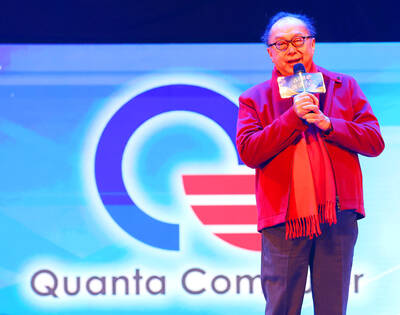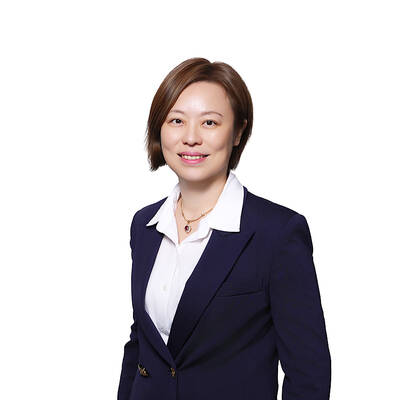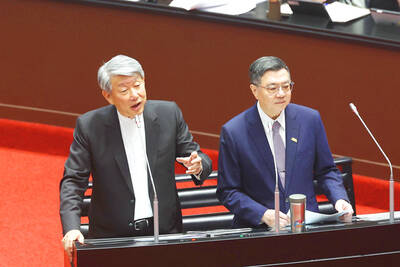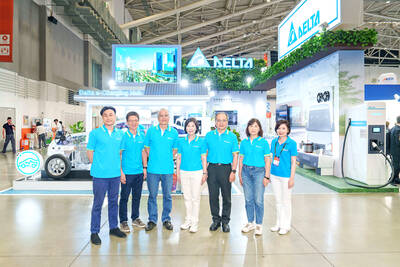Hundreds of Chohung Bank staff scuffled with riot police yesterday after a rally denouncing the South Korean government's decision to push through the sale of the state-owned bank, witnesses said.
Riot police using plastic shields formed a tight human barricade to block about 500 union members from marching out of their main office in Seoul.
Police also stopped union leaders from carrying boxes packed with thousands of letters of resignation from thousands of bank staff to President Roh Moo-hyun.
The union threatened to stage an indefinite strike next week unless the government scraps its plan to sell its 80.04 percent stake in Chohung to Shinhan Financial Group.
For his part, Finance and Economy Minister Kim Jin-Pyo vowed to conclude talks on the sale by the end of the month.
The sale would be a significant step in recovering part of the 157 trillion won (US$128 billion) in public funds the government spent bailing out financial firms since the 1997 Asian financial crisis. Chohung was nationalized in 1998, when the government injected 2.7 trillion won into the country's oldest and fourth largest lender.
In January, a state auction panel selected Shinhan, backed by BNP Paribas SA of France, as the preferred bidder to take over Chohung but a final contract has been delayed due to protests by unions demanding that Chohung stand alone.
Kim warned the government would take strong legal action against any illegal labor action.
In response, Chohung's union threatened to proceed with a walkout from June 25. Labor groups have supported the strike.

Quanta Computer Inc (廣達) chairman Barry Lam (林百里) is expected to share his views about the artificial intelligence (AI) industry’s prospects during his speech at the company’s 37th anniversary ceremony, as AI servers have become a new growth engine for the equipment manufacturing service provider. Lam’s speech is much anticipated, as Quanta has risen as one of the world’s major AI server suppliers. The company reported a 30 percent year-on-year growth in consolidated revenue to NT$1.41 trillion (US$43.35 billion) last year, thanks to fast-growing demand for servers, especially those with AI capabilities. The company told investors in November last year that

Intel Corp has named Tasha Chuang (莊蓓瑜) to lead Intel Taiwan in a bid to reinforce relations between the company and its Taiwanese partners. The appointment of Chuang as general manager for Intel Taiwan takes effect on Thursday, the firm said in a statement yesterday. Chuang is to lead her team in Taiwan to pursue product development and sales growth in an effort to reinforce the company’s ties with its partners and clients, Intel said. Chuang was previously in charge of managing Intel’s ties with leading Taiwanese PC brand Asustek Computer Inc (華碩), which included helping Asustek strengthen its global businesses, the company

Taiwanese suppliers to Taiwan Semiconductor Manufacturing Co. (TSMC, 台積電) are expected to follow the contract chipmaker’s step to invest in the US, but their relocation may be seven to eight years away, Minister of Economic Affairs J.W. Kuo (郭智輝) said yesterday. When asked by opposition Chinese Nationalist Party (KMT) Legislator Niu Hsu-ting (牛煦庭) in the legislature about growing concerns that TSMC’s huge investments in the US will prompt its suppliers to follow suit, Kuo said based on the chipmaker’s current limited production volume, it is unlikely to lead its supply chain to go there for now. “Unless TSMC completes its planned six

Power supply and electronic components maker Delta Electronics Inc (台達電) yesterday said it plans to ship its new 1 megawatt charging systems for electric trucks and buses in the first half of next year at the earliest. The new charging piles, which deliver up to 1 megawatt of charging power, are designed for heavy-duty electric vehicles, and support a maximum current of 1,500 amperes and output of 1,250 volts, Delta said in a news release. “If everything goes smoothly, we could begin shipping those new charging systems as early as in the first half of next year,” a company official said. The new